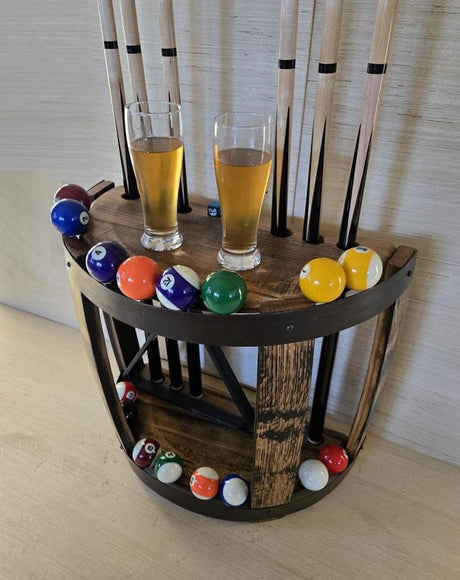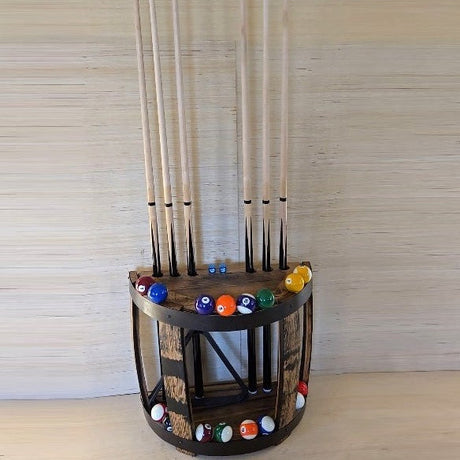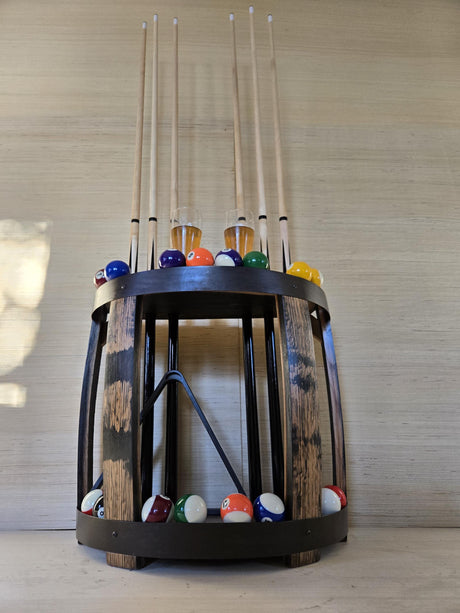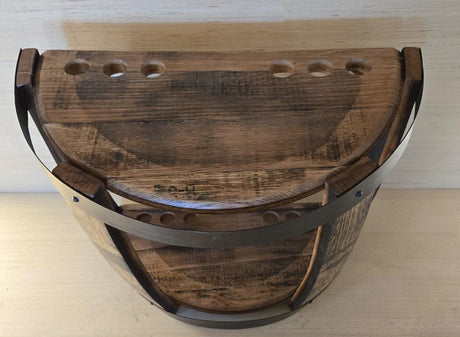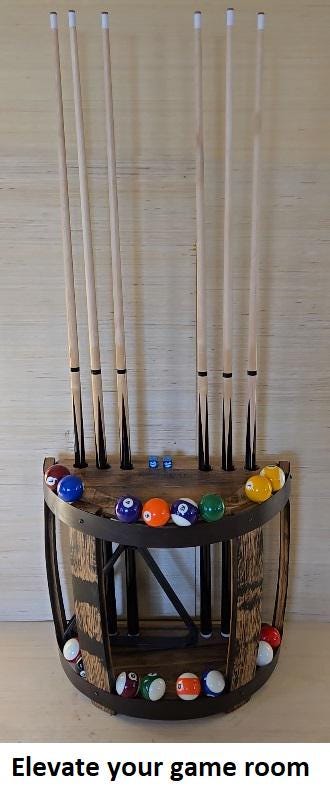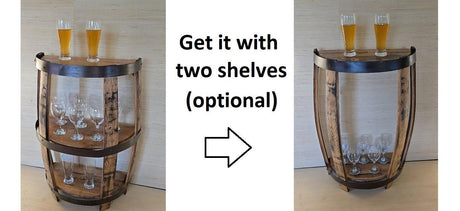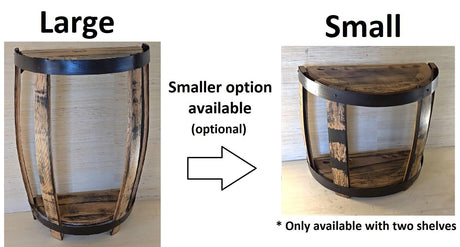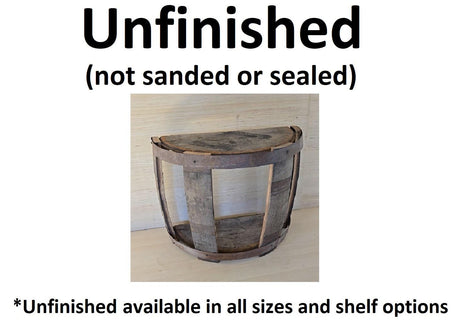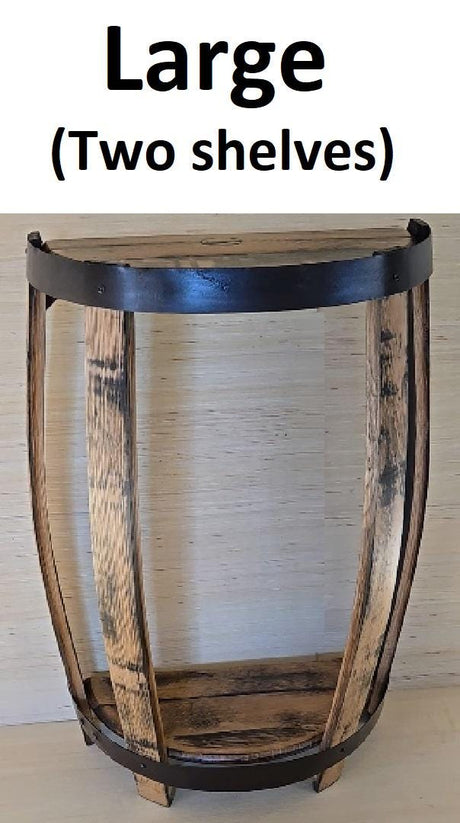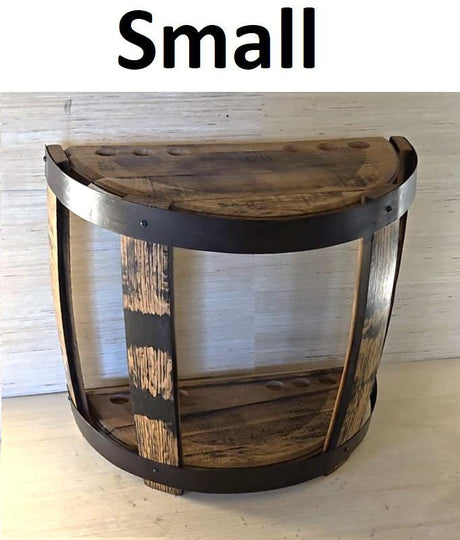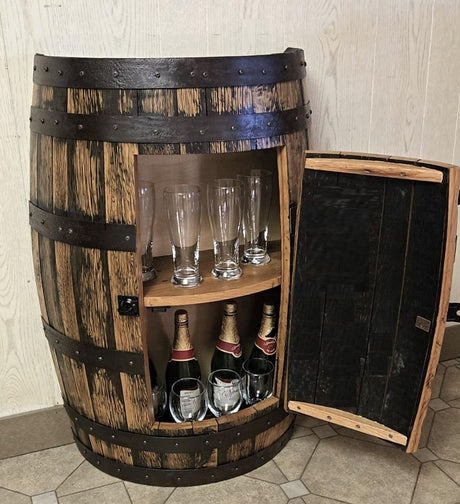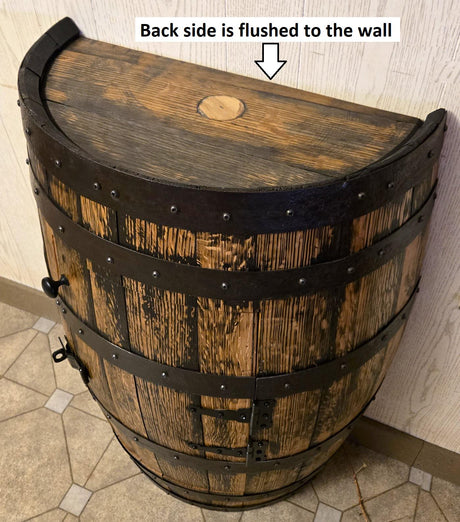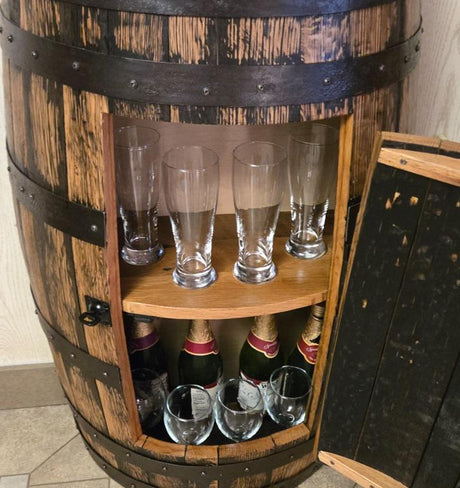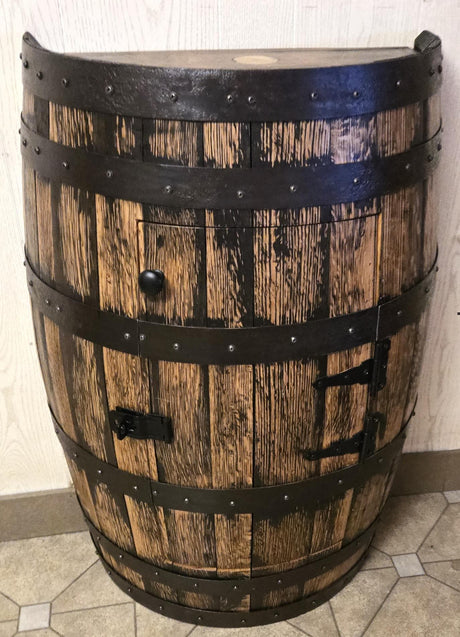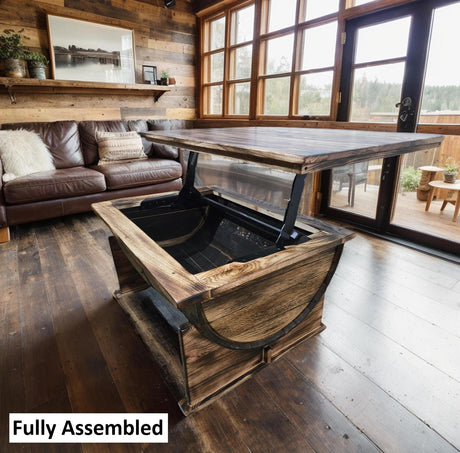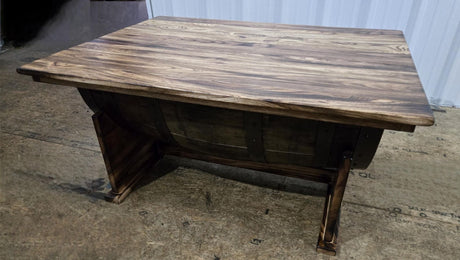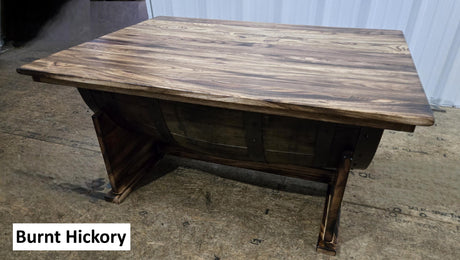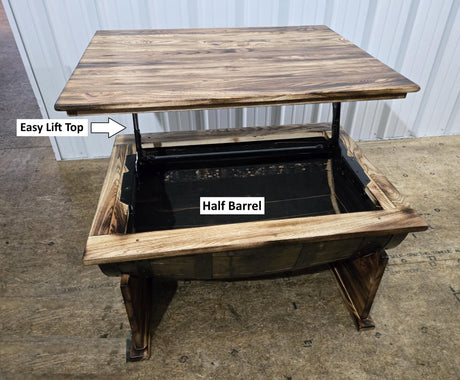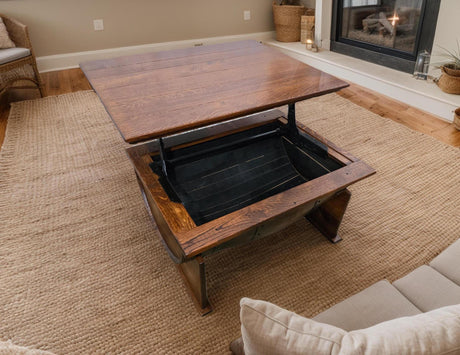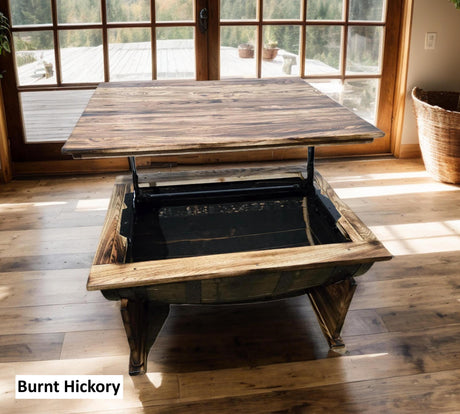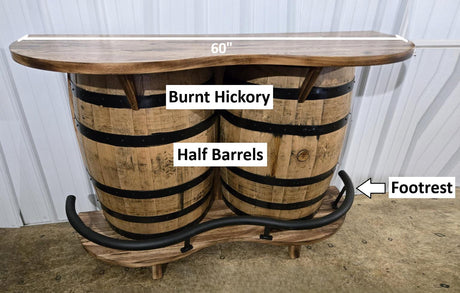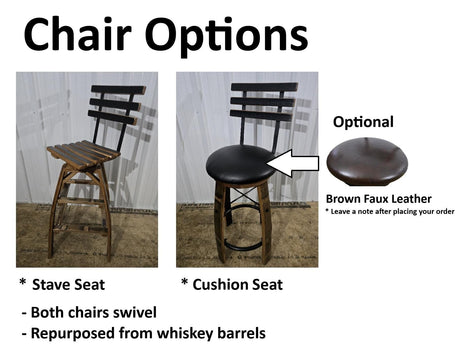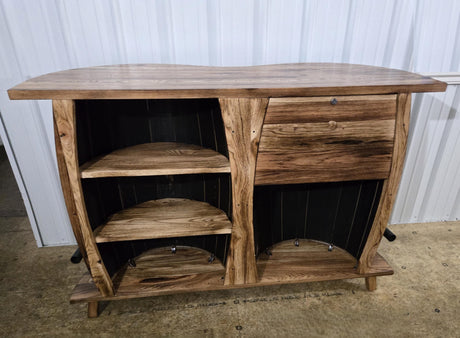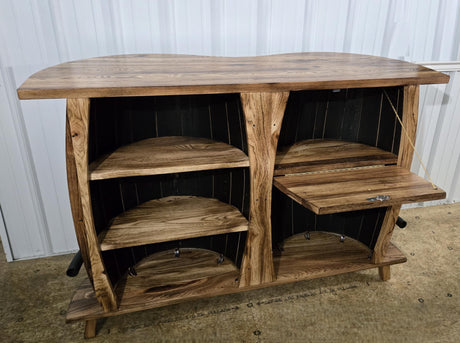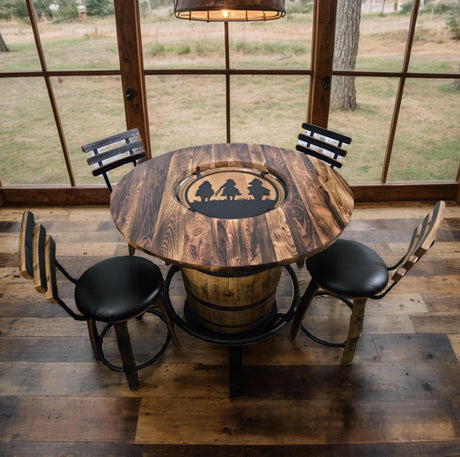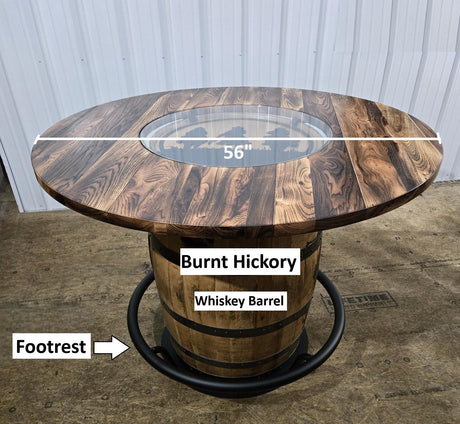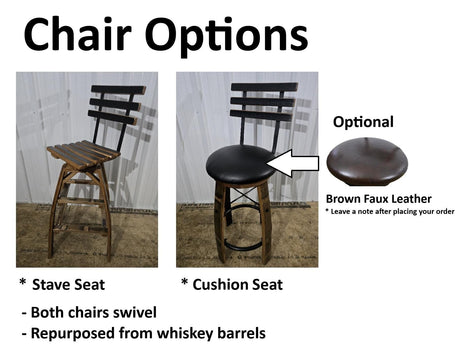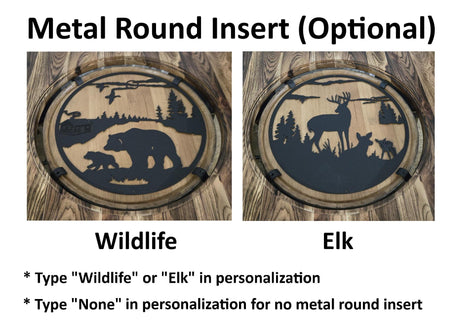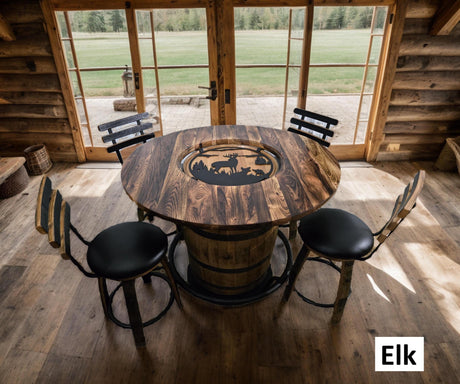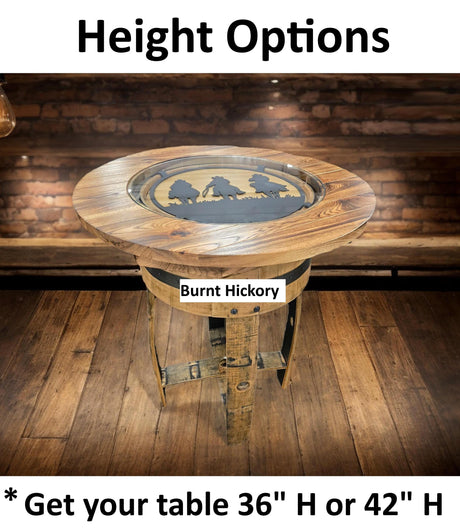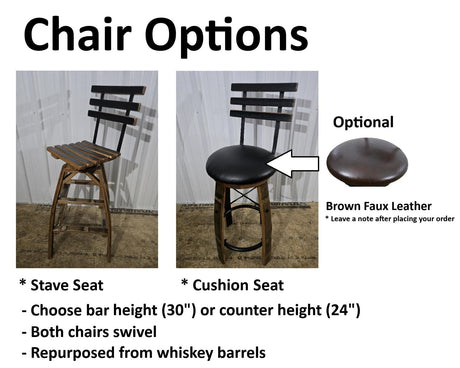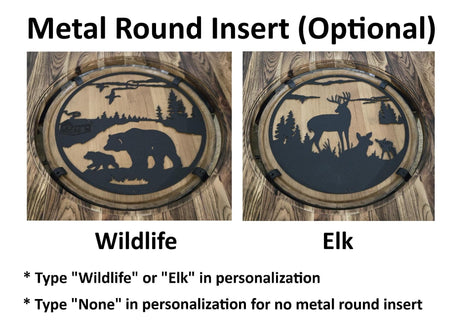- 10% off$290.99 USD
$323.99Unit price /Unavailable - Up to 10% offFrom $218.24 USD
$242.99Unit price /Unavailable - Up to 10% offFrom $533.49 USD
$593.99Unit price /Unavailable - Up to 10% offFrom $1,169.99 USD
$1,302.99Unit price /Unavailable - Up to 10% offFrom $2,133.99 USD
$2,375.99Unit price /Unavailable - Up to 10% offFrom $1,551.99 USD
$1,727.99Unit price /Unavailable - Up to 10% offFrom $1,454.99 USD
$1,619.99Unit price /Unavailable
Bring Rustic Charm Home with Amish Handmade Barrel Furniture
If you're looking to add rustic elegance and unmatched craftsmanship to your space, Amish handmade barrel furniture is a standout choice. These unique pieces bring together the beauty of repurposed materials and the precision of traditional Amish woodworking, offering a one-of-a-kind aesthetic that fits perfectly in cabins, man caves, wine cellars, and even modern rustic homes.
What makes barrel furniture so special? It starts with the materials. Many pieces are crafted from authentic reclaimed wine or whiskey barrels, often made of oak. The natural aging and patina of the wood give each piece a rich, character-filled look that can't be replicated. From the curved staves to the iron bands, every detail tells a story and the Amish craftsmanship ensures that story will last for generations.
Our collection of handcrafted Amish barrel furniture includes everything from barrel bars and pub tables to swivel stools, chairs, and even barrel sinks. Whether you’re furnishing a basement bar or adding a conversation piece to your patio, these solid wood creations bring a warm, earthy touch to any space.
Each piece is made-to-order by Amish artisans who use time-honored joinery techniques and top-quality materials. Unlike mass-produced furniture, Amish barrel furniture is built with integrity, meaning no shortcuts and no compromise on durability. The result is heirloom-quality barrel furniture that not only looks stunning but also stands up to everyday use.
In a world where furniture is often disposable, Amish handmade barrel furniture stands apart. It’s a celebration of sustainable design, expert craftsmanship, and the kind of rustic style that never goes out of fashion.

Understanding the Appeal of Rustic Cabinets
Rustic cabinets are alluring because they evoke a sense of nostalgia and connection to nature. They embody a style that prioritizes authenticity and simplicity, making them a popular choice for many homeowners.
The Aesthetic of Simplicity
Rustic cabinets are characterized by their straightforward yet charming designs. The minimalist approach often involves clean lines and unadorned surfaces that allow the wood's inherent beauty to shine through. This simplicity is appealing in today’s world, offering a refreshing break from the complexities of modern design.
Moreover, rustic cabinets often incorporate elements that tell a story, such as visible wood grain, knots, and variations in color. This organic beauty gives each cabinet a one-of-a-kind appearance, making them a focal point in any room. The tactile quality of these surfaces invites touch, encouraging interaction and appreciation of the craftsmanship involved. Homeowners often find that these cabinets not only serve a functional purpose but also become a conversation starter, sparking interest and admiration from guests.
The Charm of Natural Materials
Natural materials form the backbone of rustic cabinet design. Typically crafted from hardwoods such as oak, pine, or maple, these materials not only look beautiful but also provide durability and longevity.
Using sustainably sourced wood enhances the appeal, allowing homeowners to feel good about their choice while enjoying the stunning aesthetics. Furthermore, integrating metal accents, like wrought iron or brass handles, can add an extra layer of charm, creating a harmonious blend of rustic and refined styles.
The juxtaposition of rough-hewn wood with polished metal creates a visual interest that captures the eye and enhances the overall design.
Additionally, the versatility of rustic cabinets means they can seamlessly fit into various home styles, from traditional to contemporary, making them a wise investment for any homeowner looking to elevate their space.
Incorporating rustic cabinets into a home can also promote a sense of warmth and comfort. The natural textures and earthy tones create an inviting atmosphere, making spaces feel more lived-in and welcoming. Whether in a kitchen, bathroom, or living area, these cabinets can transform a room into a cozy retreat, encouraging relaxation and connection with family and friends. As more people seek to create homes that reflect their values and lifestyle, the enduring appeal of rustic cabinets continues to grow, offering a timeless solution that resonates with both aesthetic and emotional needs.
The Craftsmanship Behind Handmade Cabinets
Handmade cabinets reflect the expertise and skill of artisans who pour their hearts into each piece. This craftsmanship is vital in creating durable, beautiful furniture that lasts for generations. Unlike mass-produced alternatives, each handmade cabinet tells a unique story, embodying the values and traditions of the craftsperson who created it. This personal touch adds a layer of meaning and connection that resonates with those who appreciate the beauty of handcrafted items.
The Art of Woodworking
Woodworking is a time-honored tradition that requires knowledge, skill, and an eye for design. Artisans carefully select each piece of wood for its unique patterns and grain, ensuring that the final product is aesthetically pleasing and functional. The choice of wood can significantly influence the cabinet's character. For instance, oak offers a robust and timeless appeal, while walnut provides a rich, dark hue that exudes sophistication.
Techniques used in the creation of rustic cabinets may include mortise-and-tenon joints and dovetailing, which not only enhance the structural integrity but also add to the visual appeal. Each technique contributes to the story of the cabinet, providing a sense of craftsmanship that mass-produced pieces cannot replicate.
Moreover, the use of traditional tools, such as hand planes and chisels, allows artisans to maintain a connection to the past while creating functional and beautiful pieces.
The Importance of Detail
Attention to detail is what truly elevates rustic cabinets from ordinary to extraordinary. From the finish applied to the overall design, every facet is intricately considered. Natural finishes often highlight the wood's character while protecting it from wear and tear. This commitment to quality ensures that each cabinet not only looks stunning but also stands the test of time, becoming a cherished heirloom that can be passed down through generations.
In addition, small details such as hand-carved accents or unique hardware can transform a simple cabinet into a work of art. These thoughtful touches showcase the artisan's dedication and commitment to quality, making the cabinet not just a storage solution but also a cherished piece of art. Furthermore, the choice of hardware, whether it be wrought iron handles or vintage-style knobs, can enhance the overall aesthetic, tying together the cabinet's design with the surrounding decor. Each element, from the wood grain to the finishing touches, plays a crucial role in creating a cohesive and captivating piece that enhances any space it inhabits.
Choosing the Right Rustic Cabinet for Your Home

Transform your home with this timeless Amish handmade pantry cabinet, featuring a rustic design and matte black finish, perfect for adding elegance and functionality to any room.
Finding the perfect rustic cabinet involves consideration of various factors that ensure harmony with your existing décor and functionality to suit your needs.
Considering Size and Function
Before selecting a rustic cabinet, it’s crucial to assess the space where it will reside. Measure the area to define the ideal size, which helps avoid being overwhelmed or lacking functionality. Also, consider whether the cabinet will serve purely decorative purposes or if it needs to hold specific items, such as dishes, clothing, or books.
Moreover, the layout of the room should also guide your choice. A larger cabinet may work in an expansive living room, while a smaller unit could be perfect for a cozy nook or hallway. Think about the cabinet's placement as well; positioning it against a wall can create a focal point, while a freestanding piece can serve as a room divider in open-concept spaces. Additionally, consider the height of the cabinet. Taller cabinets can draw the eye upward, making a room feel more spacious, while shorter cabinets can provide a more grounded, intimate feel.
Matching with Your Home Decor
A rustic cabinet should complement your existing interior design. Whether your home is modern, traditional, or eclectic, a well-chosen cabinet can enhance the overall aesthetic of your space.
- If your home has a modern vibe, choose a rustic cabinet that incorporates sleek lines and minimal ornamentation.
- For a traditional look, consider cabinets with intricate carvings and classic hardware.
- If your style is eclectic, look for unique pieces that mix rustic charm with various elements, such as color and texture.
In addition to style, consider the materials used in the cabinet’s construction. Solid wood options, such as oak or pine, can provide durability and a timeless appeal, while reclaimed wood can add character and a story to your space. Metal accents, such as wrought iron handles or hinges, can also enhance the rustic feel while providing a modern twist. Furthermore, think about the finish of the cabinet; a distressed or weathered look can evoke a sense of history and warmth, making the piece feel like it has always belonged in your home.
Lastly, don’t forget about the functionality of the cabinet. Look for features that enhance usability, such as adjustable shelves, soft-close doors, or built-in lighting. These elements not only improve the cabinet's practicality but also add a layer of sophistication to its design. As you explore your options, envision how the cabinet will interact with your daily life and the activities you engage in at home, ensuring it becomes a cherished part of your living space.
Amish Handmade Bookcases: Timeless Craftsmanship for Every Space
Amish handmade bookcases combine traditional woodworking techniques with high-quality hardwoods to create furniture that’s as beautiful as it is functional. Built by skilled Amish craftsmen in the USA, these bookcases are known for their durability, classic design, and heirloom-quality construction no particleboard, no shortcuts, just solid craftsmanship that lasts for generations.
Whether you're furnishing a home office, living room, or study, an Amish bookcase adds warmth, charm, and lasting value to any space.

Understanding the Basics of Lodge Design
The charm of a wooden lodge lies in its unique blend of functionality, comfort, and artistry. Designers and homeowners alike are drawn to the rustic aesthetic that wooden lodges provide, often complemented by beautiful, wooden handmade furniture crafted by Amish American craftsmen.
Understanding the basics of lodge design involves recognizing the significance of materials, layout, and the surrounding environment. Each element contributes to the overall ambiance, making it essential to approach the design with intention.
Simple, sturdy, and full of character this Amish Art TV cabinet blends Amish tradition with modern farmhouse appeal.
The Importance of Choosing the Right Wood
Choosing the appropriate type of wood is critical in constructing a lodge for aesthetic appeal and durability. Different woods possess varying characteristics in color, grain, and resistance to the elements.
- Hardwoods: Options like oak, maple, and cherry offer durability and a rich appearance.
- Softwoods: Pine and cedar are commonly used for their affordability and ease of work.
- Sustainable options: Look for woods sourced from responsibly managed forests to minimize environmental impact.
Each choice of wood will affect the lodge's overall look, feel, and longevity, making it a fundamental aspect to consider during the design phase.
The choice of wood can influence the lodge's thermal properties, which is crucial for maintaining a comfortable indoor climate regardless of the season. For instance, certain woods have better insulating properties, helping to keep the lodge warm in winter and cool in summer, thus enhancing energy efficiency.
Amish Handmade Barrel Furniture: Rustic Elegance with Authentic Character
Amish handmade barrel furniture brings together traditional craftsmanship and rustic style by repurposing real wooden barrels into functional, eye-catching furniture pieces. Whether it’s a wine barrel bar, a barrel coffee table, or a barrel chair set, each piece is handcrafted by Amish artisans using solid wood and time-honored techniques. Perfect for cabins, man caves, wineries, or rustic-themed homes, this furniture adds warmth, charm, and a story to your space.
Incorporating Rustic Elements in Your Design
Rustic elements can transform a wooden lodge into a sanctuary connected to nature. Various design features can be integrated to highlight the natural essence of the lodging environment.
- Exposed beams: Highlighting structural beams adds a traditional look and emphasizes craftsmanship.
- Natural stone: Using stone for fireplaces and accents brings a touch of the outdoors inside.
- Vintage fixtures: Incorporating antique lamps, handmade furniture, or other vintage decor can enhance the rustic vibe.
By employing these elements, the lodge's design will reflect a captivating balance between comfort and nature, appealing to those seeking refuge from modernity.
Integrating large windows or glass doors can create a seamless transition between the indoor and outdoor spaces, allowing natural light to flood the interiors while offering breathtaking views of the surrounding landscape.
This connection to the outside world enhances the aesthetic appeal. It promotes a sense of tranquility and well-being, making the lodge a true retreat from the hustle and bustle of everyday life.
Planning Your Wooden Lodge
Planning is an integral part of the lodge design process. It allows for considering aesthetics and practicality, ensuring the finished product meets users' needs while pleasing the eye. This planning encompasses various factors that contribute to the functionality and comfort of the space.
A well-thought-out plan enhances the lodge's visual appeal and ensures it harmonizes with its natural surroundings, creating a seamless blend between the built environment and the landscape.
Key Factors to Consider in Lodge Design
Before embarking on the actual design, it is essential to outline key factors that can significantly shape the lodge’s ultimate appearance and utility. These include:
- Location: The natural surroundings dictate the style and materials best suited for your lodge. A lodge nestled in a forest may benefit from earthy tones and natural wood finishes, while one near a lake might incorporate large windows to maximize views.
- Size: Consider the number of occupants and the ideal living space required. It's crucial to balance spaciousness with coziness, ensuring that the lodge feels inviting without being overwhelming.
- Climate: The design must accommodate temperature variations, with appropriate insulation and ventilation systems. In colder climates, features like a mudroom for gear storage and heated floors can enhance comfort, while in warmer regions, shaded outdoor spaces can provide relief from the heat.
Taking these considerations into account early in the planning phase will save time and ensure a smoother design process. Additionally, engaging with local experts can provide insights into the best practices for building in specific environments, ensuring that your lodge is beautiful and functional.
Space Planning for Comfort and Functionality
Space planning should focus on creating comfortable living areas that serve multiple purposes. An open floor plan can effectively use space while promoting a sense of togetherness among occupants. This layout encourages interaction and allows natural light to flow throughout the lodge, enhancing the overall ambiance.
Consider dividing the interior into distinct zones:
- Living area: A cozy space for relaxation with comfortable seating and a central fireplace. Building shelving for books and games further enhances this area, making it a hub for entertainment and leisure.
- Dining area: A communal table that encourages gatherings and family meals. Adding a large window or glass doors can create a connection with the outdoors, allowing diners to enjoy views of the surrounding landscape while sharing a meal.
- Sleeping quarters: Enclosed or semi-private spaces that provide a restful atmosphere. Thoughtful design elements, such as soundproofing and blackout curtains, can ensure a peaceful night's sleep, while personal touches like unique bedding or artwork can make each room feel special.
Designing these areas thoughtfully enhances usability and can significantly elevate the wooden lodge experience.
Incorporating flexible furniture options, such as foldable tables or convertible sofas, can maximize space efficiency and adapt to the varying needs of different groups, whether it's a family gathering or a retreat with friends.
Interior Design Tips for a Rustic Look
The interior design of a wooden lodge should reflect its rustic character while ensuring warmth and comfort for its inhabitants. Choosing appropriate furnishings, color palettes, and decor is key to achieving this balance.
Selecting Furniture for Your Wooden Lodge
When choosing furniture, prioritize items that complement the natural materials of the lodge. Look for:
- Natural finishes: Opting for wood furniture with a natural or distressed finish enhances the rustic aesthetic.
- Handmade pieces: Unique, handcrafted items can bring character and a personal touch.
- Cozy textiles: Incorporate wool, linen, and cotton for comfort and warmth.
The goal is to create an inviting atmosphere where guests can feel at home, surrounded by nature's elegance. Consider adding oversized sofas and plush armchairs that encourage relaxation, making them ideal for curling up with a good book or enjoying a glass of wine by the fire.
Additionally, incorporating multifunctional furniture, such as ottomans that double as storage, can help maintain a clutter-free environment while enhancing the lodge's rustic charm.
Choosing the Right Color Palette
A well-chosen color palette can elevate the overall ambiance of a wooden lodge. Earthy tones such as warm browns, deep greens, and muted grays resonate with the surroundings, creating harmony between the interior and exterior.
Consider the following tips for color selection:
- Monochromatic schemes: Use varying shades of a single color to produce a cohesive look.
- Accents: Add pops of color through decor and accessories to create visual interest.
- Textures and layers: Combine different materials (wood, metal, fabric) to add depth.
Selecting the right color palette sets the tone for relaxation and comfort, evoking the natural beauty that a wooden lodge embodies.
To further enhance the rustic feel, consider incorporating natural elements such as stone or brick accents on walls, which can add an organic touch and create a sense of permanence. Additionally, soft, ambient lighting can highlight these colors and textures, creating a warm glow that invites guests to unwind and enjoy their surroundings.
Outdoor Considerations for Your Lodge
The outdoor space of a wooden lodge is just as important as the interior. It allows for a seamless connection to nature, providing additional living space that can be beautiful and functional.
Designing a Lodge-Style Landscape
A well-designed landscape complements the lodge while enhancing its rustic charm. Here are a few essential elements to consider:
- Native plants: Choose plants that thrive in the local climate, contributing to biodiversity and sustainability.
- Pathways: Installing stone or wood pathways can create inviting routes through the landscape.
- Water features: Incorporate features like ponds or streams to attract wildlife and enrich the auditory landscape.
These elements enhance visual appeal and provide ecological benefits, making the outdoors a paradise. Consider the seasonal changes in your landscape design.
Incorporating a variety of plants that bloom at different times of the year can ensure that your outdoor space remains vibrant and engaging throughout all seasons. For instance, spring bulbs can provide early color, while late-blooming perennials can extend their beauty into the fall.
This thoughtful approach to seasonal planting will create a dynamic environment that invites exploration and appreciation year-round.
Creating an Inviting Outdoor Living Space
Having an outdoor living area expands the functionality of the lodge by offering additional space for relaxation and entertainment. Prioritize comfort and aesthetic appeal in the design of this area.
- Seating arrangements: Use weather-resistant furniture to create areas for lounging or dining.
- Fire pits: Design a communal fire pit space to foster evening socializing.
- Shade solutions: Include pergolas or shade sails to protect against the sun while enjoying the outdoors.
By thoughtfully designing an outdoor living space, you invite guests to enjoy the fresh air and scenic surroundings, enriching their experience of the lodge. Consider adding outdoor lighting to enhance the ambiance during the evening hours.
String lights or lanterns can create a warm, inviting atmosphere, making the outdoor space feel cozy and welcoming. Furthermore, incorporating elements like outdoor rugs and cushions can add a touch of comfort and style, transforming the area into a true extension of the lodge’s interior.
This attention to detail elevates the aesthetic and encourages guests to linger longer in the beauty of the natural surroundings.
Designed for gathering, prepping, and admiring—this handcrafted kitchen island from Amish Art anchors any rustic kitchen with warmth and artisanal charm.
Maintaining the Aesthetic of Your Wooden Lodge
Once your wooden lodge is designed and constructed, it’s crucial to maintain its aesthetic to ensure longevity and beauty. Regular upkeep will preserve functionality and the rustic charm that defines the lodge's character.
Regular Maintenance and Upkeep Tips
Regular maintenance keeps the lodge looking pristine and prevents larger issues down the line. Consider these strategies for upkeep:
- Inspect wood surfaces: Regularly check for signs of wear or rot; treating wood with sealants can improve its lifespan.
- Cleaning: Dust and wash furnishings periodically to avoid the accumulation of dirt.
- Outdoor care: Ensure outdoor furniture and spaces are maintained, especially after heavy weather.
By staying proactive with maintenance, you can ensure your lodge remains a welcoming retreat for years. Consider scheduling seasonal inspections where you can assess the structure's integrity, checking for any potential issues that may arise due to changing weather conditions.
This practice not only helps in the early detection of problems but also allows you to enjoy the beauty of your lodge in different seasons, appreciating how the light and landscape transform the space.
Preserving the Rustic Charm Over Time
As time passes, preserving a wooden lodge's rustic charm requires a balance between modern needs and traditional aesthetics. Consider incorporating:
- Restorative repairs: Repairing rather than replacing furniture or fixtures keeps the history alive.
- Seasonal updates: Refreshing decor with seasonal elements can keep the space inviting.
- Integrating technology: Modern conveniences should blend seamlessly without overtaking the rustic elements.
Maintaining this balance will help to ensure that the sense of peace and connection to nature that a lodge embodies remains intact, making it a cherished space for future generations.
Embracing natural materials in your updates, such as wool throws or stone accents, can enhance the lodge's authenticity while providing comfort. Engaging with local artisans for custom pieces can also add a unique touch, ensuring each item tells a story and reflects the surrounding environment, thus deepening the lodge's connection to its natural setting.
When living in an apartment, tiny home, or another small space every square inch counts. Choosing the right furniture can make a significant impact on the functionality and aesthetics of your home.
This also doesn't mean you just have to buy cheap, particle board furniture manufactured for seemingly disposable consumption! High-quality, multi-functional pieces of furniture are more affordable than you think. Also, investing a little extra in a few pieces of small furniture can be a big help if you scale up in your life at some point.
Let's explore some key considerations for selecting functional furniture for small spaces.
What are the benefits of functional furniture?
Functional furniture is designed to serve multiple purposes, making it ideal for small spaces. By choosing pieces that offer storage solutions, convertible features, or compact designs, you can maximize the use of your limited space.
Pieces like this Entry Table from Amish Art are extremely versatile. It can be used as a Nightstand, Bathroom Cabinet, or even in a Kitchen! Since it's available in multiple finishes, you can even order multiples and make each room stand out.

What should you consider when selecting furniture for small spaces?
When shopping for furniture, prioritize pieces that are appropriately scaled for your space. Opt for slim profiles, modular designs, and furniture with exposed legs to create a sense of openness. Additionally, choose light-colored furniture to make the room feel more spacious.
Amish Art offers several slim pieces of furniture to fit this need. Pieces like our Rustic Cupboard or this Pantry Cabinet work great to add each storage to a small kitchen or bathroom.
How can you create the illusion of space with furniture?
Strategic placement of furniture can make a small space appear larger. Consider using mirrors to reflect light and create depth, or opt for transparent furniture like glass tables to maintain an airy feel. Avoid overcrowding the room with too many pieces, and aim for a minimalist approach to decor.
Final thoughts on furniture selection for small spaces
By carefully selecting functional furniture that is tailored to the specific needs of your small space, you can create a comfortable and stylish environment that maximizes every inch. Remember to prioritize quality, versatility, and aesthetics when choosing furniture for your compact living space.
If you are need of specially sized piece of small furniture, reach out to us to here >>>
Are the barrels real or decorative?
Amish barrel furniture typically uses authentic reclaimed barrels, which may have been used to age wine, whiskey, or bourbon. The wood is aged, charred, and full of character, making each piece truly one of a kind.
Is Amish barrel furniture environmentally friendly?
Yes! Many Amish craftsmen prioritize sustainability by repurposing authentic used wine and whiskey barrels that would otherwise go to waste. The use of reclaimed hardwoods and non-toxic finishes also makes barrel furniture a smart eco-conscious choice.
Is each barrel furniture piece unique?
Yes, and that’s the beauty of it. Every reclaimed barrel has its own texture, markings, and color variation, which means no two pieces are exactly alike. The aging process, former use (whiskey vs. wine), and grain pattern all contribute to each piece's one-of-a-kind appearance.
How long does Amish farmhouse furniture last?
With proper care, Amish furniture can last 50–100 years. It’s designed to be heirloom-quality passed down for generations.
Why choose unique handmade furniture over mass-produced options?
Mass-produced furniture is often built with cheap materials and shortcuts. Handmade pieces use solid wood, offer customizable designs, and last for decades combining beauty with function in a way no factory piece can.
Is handmade furniture more durable than store-bought furniture?
Absolutely. Handmade furniture is typically crafted from solid hardwood using time-tested joinery, making it far stronger and longer-lasting than flat-pack or veneered furniture.



